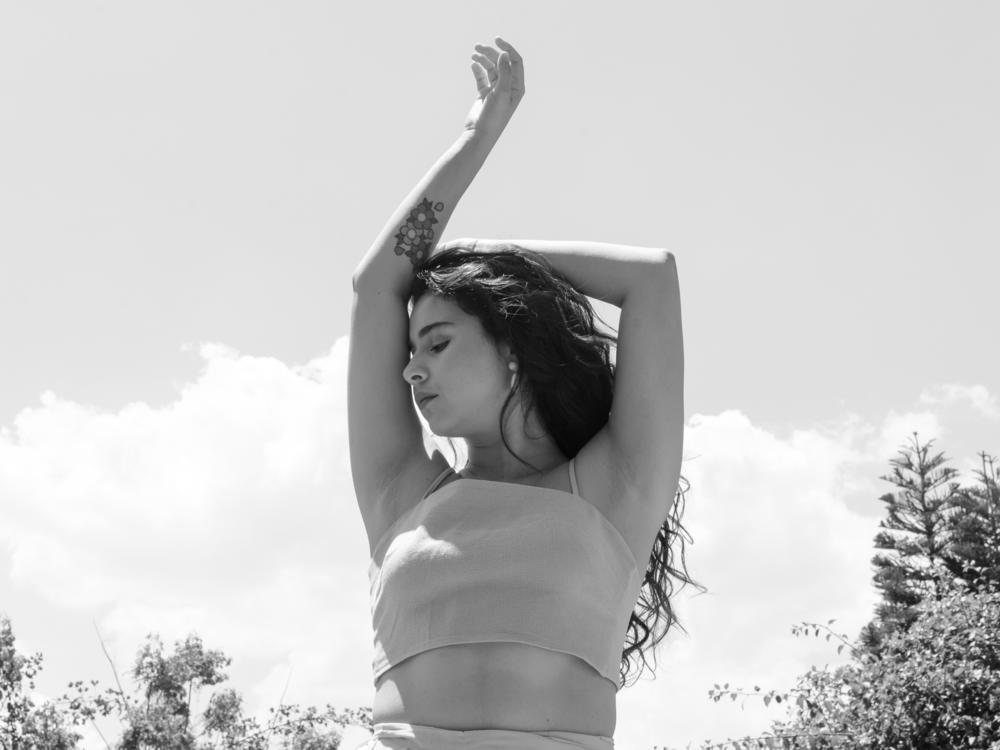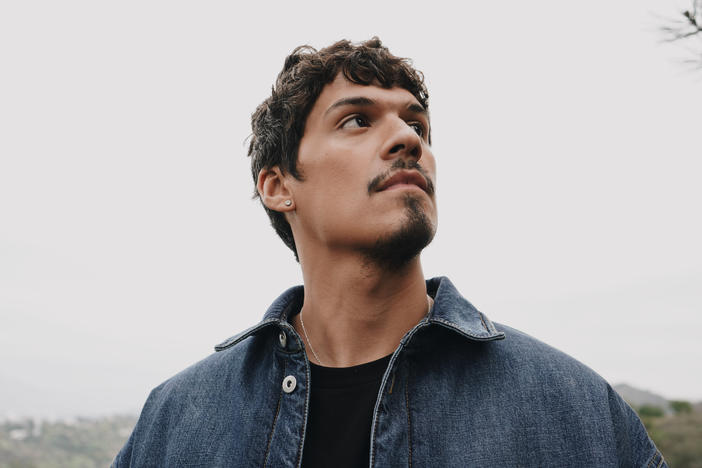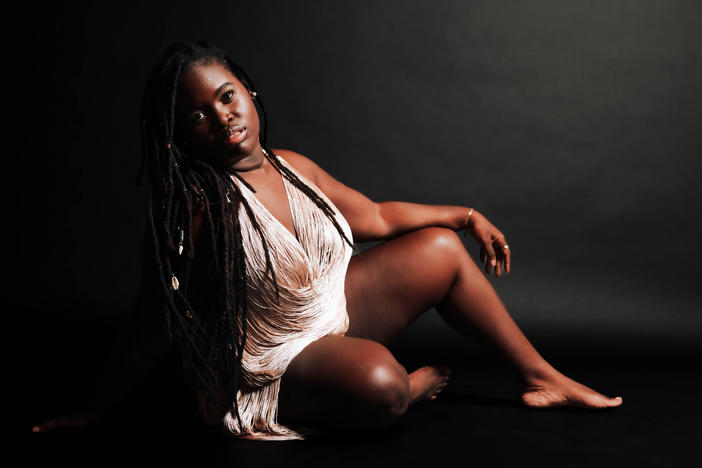Section Branding
Header Content
Silvana Estrada wants you to find the song in your soul
Primary Content
Silvana Estrada never danced the way she was expected to. As a little girl growing up in Veracruz, Mexico, the singer-songwriter tried to find her groove in ballet like all the other little girls, matching metronome ticks with sharp pointed toes and perfect right angles. But other people soon made it clear that the delicate piano was inspiring her to sashay her bigger body in all the wrong ways. "No necesitamos eso," her mother said, and with that they ditched the blush pink leotards and satin-sheathed shoes for dance classes she could move freely in, focusing on a more intensely percussive, liberating African-rooted dance.
She fell in love. From that point forward, everything became about chasing those soul-touching, all-consuming percussive rhythms that could prompt anyone within earshot to abandon their thoughts and move. "The sense of rhythm [that being in those kinds] of dance classes gave me is something I still have. This idea that music is good, it feels good in your body," Estrada tells NPR. "For me, it's like I really need rhythmic structure."
The fledgling singer-songwriter debuted to a wider audience in 2017, when she released Lo Sagrado with acclaimed American guitarist Charlie Hunter. The collaborative album was a sweet, masterfully delicate work that showcased the artist's jazz-filled roots but didn't possess the beats and structure necessary to display the inner workings of her dancer's soul. Still, many in Latin America and beyond were hooked by her unique ability to harness physicality, and following the release of her own EP Primeras Canciones, she was approached by big-time folk/indie label Glassnote.
To know Estrada's work is to be captivated by what's next, and at 24 years old she's delivered with her recently released debut solo album, Marchita. The album is filled with strong percussive moments and chest-gripping rhythms, assembled with claps, stomps, and guttural, almost unrecognizable, vocal stints on tracks like "Un Día Cualquiera." With meandering melodies and softer beats found on songs like "Carta," she showcases a complete and authentic Silvana Estrada — pulsing with equal parts "fuerza" and heart, tethered to the earth by the limits of her imagination alone.
A child of musicians and instrument makers, Estrada grew up in a sanctuary removed from judgmental eyes and ripe for free expression. Home was where the artist could embrace her instincts and navigate the wooden bodies that surrounded her in all the right ways. Growing up listening to the greats — Ella Fitzgerald, Billie Holiday, Mercedes Sosa — she tried to find the space and time where their bodies met. She'd focus on the moments in which their sounds overwhelmed her "corazón," just like she'd experience in her African dance classes, and let them dictate the way she strung songs together. It was those moments that gave Estrada the space to play, imagine and connect with the body using the parameters of a rich and storied musical structure.
"We have this misconception that everything that has to do with the body has to be amazingly happy, this rhythmic kind of dance music," Estrada says, adding that this misconception is limiting. "If I listen to Billie Holiday, that completely crushes my chest and, you know, that's physical. It's so timeless, that feeling."
On Marchita, she manages to chisel concrete structures out of the ethereal feelings she was attempting to imitate using the two best tools she discovered in her workshop: her voice and the cuatro venezolano. "The production of my album is really just letting my vocals travel and have the opportunity to actually go directly right to your chest and to make your chest vibrar," Estrada shares. "And that's something I've been working on without knowing I was working on that. Like, oh my god, if I sing this way it feels nice. It feels nice in my chest or in my belly and that always creates something [for the people] in the other side of the story, the people who are listening to that feel something."
Following her voice brought Estrada to rendezvous with Billie and Mercedes, and on Marchita her vocals are the stuff of legends. Within her silky tones and enchanting vibrato the space time continuum is subverted and eons of preserved passions come flooding in. The cuatro venezolano anchors her vocals in the present, turning stolen kisses and turbulent affairs into reliable melodies and buttery-smooth harmonies, a pairing that keeps her firmly centered. The other instruments add all kinds of hues to the music, but she operates in thin, dark lines, the rhythmic center grounding her multilingual, global audience in the soul of the music.
In her careful hands, relinquishing themselves to her cuatro and voice, those who see her live in concert are taken on a careful exploration of the ages. They are often guided less by the substance of her words and more by the way they ebb and flow, shape-shifting and swirling through bodies in the room. "I try for all my music to be beyond language," Estrada says. "I'm about to have a tour in the U.S. and I know all the people in the audience aren't going to be Spanish speakers. But I do know all of these people will have souls or hearts or experiences, [and] bodies who will feel something."
For those who can make out the meaning of her textured poetry, an entire universe is unveiled. The utilitarian body reemerges, employed less as a flat brush used for blending worlds and more as a scalpel for incising her heart and revealing her own limitations. "Tengo una voz y una piel / Que quieren que tu las descifres / Tengo la vida muy corta / Para entender lo que dicen (I have a voice and a skin / That want to be deciphered by you / My life is too short / To understand what they say)," she sings on "Te Guardo (For You I'll Keep)." In a moment of self-imposed weakness she lays bear her naivete, losing her greatest asset to someone else's definition.
To the casual ear, moments like these can validate a desire to toss Marchita aside as just another debut album about first love. But a more in-depth listen reveals Estrada, once again, employing her subversive "brujeria" to transcend experience. She uses her own supposed youthful naivete to expose raw truths and dive into painful topics most seasoned artists struggle to confront, much less address directly.
Applying a seemingly antithetical, joy-filled sense of rhythm to explore themes like death, loss and nostalgia — "marchita" translates to withering in English — she makes the most unpleasant and painful life has to offer appreciable. I ask her about this tension, how she's been able to build the layers of her universe, finding a space for joy and dance and death. "I'm Mexican," she giggles.
Beyond the walls of the Estradas' picturesque "taller" exists yet another stratum, a world with a different set of emotions and politics. Veracruz, Mexico is a wildly complex painting filled with rich colors of cultural history — as well as some darker hues. In 2021, it was ranked the Mexican state with the highest rate of violent attacks against politicians according to consulting firm Etellekt, a reality that has colored the way Estrada views death and life and the line of emotions that lie between them.
"We are so close to horror, really," Estrada says, of living in Veracruz. "But at the same time [we have] delicious food and amazing music and have all these contrasts. At the end of the day I think it's like a lesson of the whole, the whole picture has beauty [in] it, not just one side."
Marchita won't be found accompanying swishing hips in salsa clubs or bouncing bodies in discos, but the young singer's sharp instincts and expansive knowledge of much of what life has to offer — the exuberant and the horrible — give it a beating heart and a dancing power "mas fuerte que" most debut albums. At 24 years old, she consistently relies on her own ability to bring herself back to Earth. "Above everything, every word, every concept still [happens] in our bodies, right?" she says. "I'm a body that can create sounds like every other body."
There's a brevity to the way Estrada carries herself that fills every corner of Marchita. Songs like "La Corriente" rely on powerful prose and stunning strings to render beautiful images immortal. Invoking a lightness of soul to excavate the calcified crevices of reckless love she coos, "Cambiaste mareas y corrientes / Dejaste tu nombre en el mar / Volteaste la cara sonriente / Y yo que no supe nadar (You changed tides and currents/ You left your name on the sea / You turned a smiling face / And I knew not how to swim)." Even on more eerie pieces like the organ-driven "Casa" or the heart-wrenching "Tristeza" there's still an air of mysticism and fantasy that guides the carefully laid tracks.
"I guess it's really important to internalize the joy, right?" she says. It took her a minute to find the right word for "internalize," likely because it's one of those experiences frequently felt and so rarely spoken of, something that lives closer to the chest than the brain.
During long days on the tour bus and nights spent sharing secrets with crowds of strangers, she's found herself revisiting her first love, the one who introduced her to effortless joy. Whether she spends five minutes letting out dance-adjacent wiggles backstage or an hour tapping into an old class routine, she finds it's crucial in preserving her own well-being and continually cultivating honesty in her craft. "Every time I have a joyful, physical experience, I kind of connect that joyful moment with what I do because singing is also a joyful physical experience," Estrada says.
In Estrada's workshop, joy and loss sway to the same melodies. When you have a calling as seismic, all you can do is follow the beat in your bones and the vibration of your vocal chords to a higher plane. On Marchita, she invites the listener to join her there, and abandon whatever respective worlds or languages they come from. Estrada is asking us to defy expectations and look inwards, to the song in our souls, to see if, even just for a moment, we can dance together in all the wrong ways at the exact same frequency.
Copyright 2022 NPR. To see more, visit https://www.npr.org.
Bottom Content




